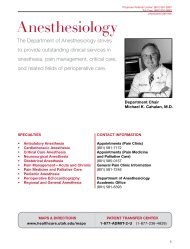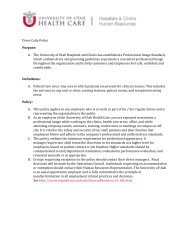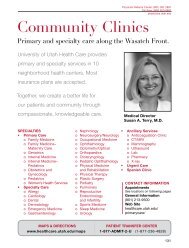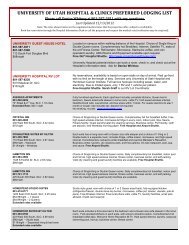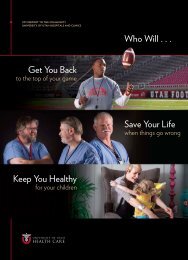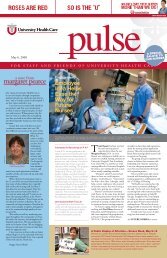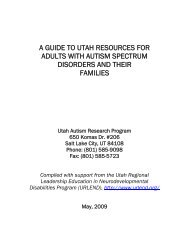Crisis Cycle - University of Utah Health Care
Crisis Cycle - University of Utah Health Care
Crisis Cycle - University of Utah Health Care
Create successful ePaper yourself
Turn your PDF publications into a flip-book with our unique Google optimized e-Paper software.
Summer 2007<br />
<strong>Crisis</strong> <strong>Cycle</strong><br />
We all experience stressors that lead to escalation. This cycle is typically referred to as the <strong>Crisis</strong> <strong>Cycle</strong>.<br />
By following basic recommended responses, you can minimize the time and intensity <strong>of</strong> each episode.<br />
An awareness <strong>of</strong> each phase and possible responses promotes better outcomes for all involved.<br />
Phases in <strong>Crisis</strong> <strong>Cycle</strong><br />
Baseline/In Control- Person is calm and displaying their normal everyday behavior.<br />
Trigger- Person experiences a stressor which may be physical, environmental or social (e.g. a loud<br />
noise, crowd, hunger, demand, etc.)<br />
Escalation- Person continues to show increased signs <strong>of</strong> agitation. Behaviors may intensify (e.g.;<br />
pacing, swearing, attempting to hit, verbally threatening, etc.)<br />
<strong>Crisis</strong>- Person is out <strong>of</strong> control and loses ability to process information. Person may be physically<br />
aggressive (e.g., hitting, kicking, biting, etc), engage in self-injurious behavior(e.g., biting hand, head<br />
banging, etc.), verbally assaultive (e.g., swearing, name calling, racially <strong>of</strong>fensive remarks), running away, etc.<br />
Calming Down- Person begins to regain control, and behavior becomes less intense.<br />
Recovery- Person has regained control but remains fragile.<br />
Crash- Person may drop below normal activity level and need quiet time (e.g. sleep, relax).<br />
Remember!!!<br />
Take 3 deep breathes and be aware <strong>of</strong> where you are in the crisis cycle.<br />
By being prepared and aware <strong>of</strong> your own behavior and surroundings, you can work<br />
more quickly to calm down the individual who is in crisis.
CASE EXAMPLE<br />
Phase<br />
0. Baseline/In Control:<br />
Jane is interactive and compliant.<br />
1. Trigger:<br />
Jane is told “no” when she asks for<br />
candy.<br />
Jane starts loudly demanding the<br />
candy.<br />
2. Escalation:<br />
Jane is standing and screaming,<br />
“CANDY NOW!”<br />
3. <strong>Crisis</strong>:<br />
Jane is swearing and swinging at<br />
others in the grocery store.<br />
4. Calming Down:<br />
Jane is quietly standing in the grocery<br />
store isle.<br />
5. Recovery:<br />
Jane is sitting quietly in the car.<br />
6. Crash:<br />
Upon arriving home Jane takes a 2<br />
hour nap.<br />
Recommended Responses<br />
Positive Support:<br />
“Jane, I like how you are following directions.”<br />
Be aware <strong>of</strong> environment & body language.<br />
Reinforce desired behavior.<br />
Have fun.<br />
Remove or at least minimize trigger:<br />
“Jane you get candy after lunch.”<br />
Stay positive and calm.<br />
Redirect attention.<br />
Be aware <strong>of</strong> your body language and theirs.<br />
Maintain your exit at all times.<br />
Two Choices:<br />
“Jane, you can sit down or go for a walk.”<br />
Set limits by <strong>of</strong>fering two choices.<br />
Stay at least arms length away.<br />
Scan area -- remove potentially dangerous items (e.g., scissors,<br />
staplers, sharp objects, etc).<br />
Safety First/Least Restrictive:<br />
“Jane, get in control.” After telling Jane to get in control, stop talking &<br />
think!<br />
Get help if needed.<br />
Remove audience.<br />
ONLY one person talks at a time.<br />
Use body positioning and physical redirection when/if appropriate.<br />
Structured Relaxation:<br />
Jane can easily re-escalate if requests are made too soon. Respect<br />
Jane’s process for calming down.<br />
Observe from a distance.<br />
Remove stimuli when possible (e.g., people, objects, noises, lights, etc).<br />
Respect the person’s process for regaining control.<br />
Positive Support:<br />
“Jane, nice job calming down.”<br />
Do not discuss the incident at this time.<br />
Return to regular schedule if appropriate.<br />
Reinforce desired behavior.<br />
Positive Support:<br />
Jane drops below baseline needing time to rest.<br />
Person may be tired and need sleep.<br />
Person may need quiet time.<br />
Remember!!!<br />
A Person may skip phases and return to previous phases depending on<br />
interventions, circumstances, and personal responses.<br />
Written By: Patricia Galbraith LCSW, Taryn Nicksic-Springer M.Ed. & Stephanie O’Brien M.S.




